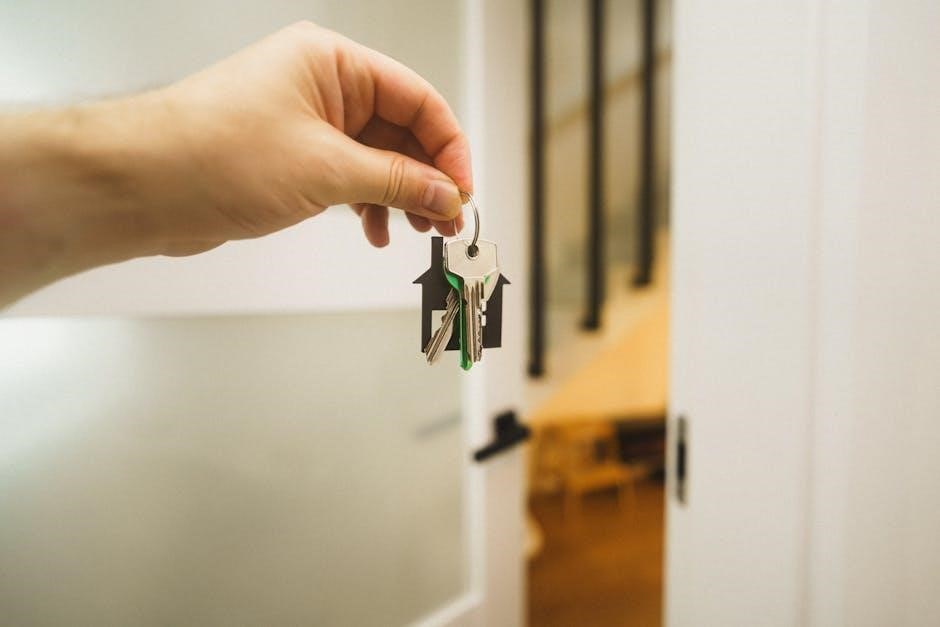Embarking on your first home-buying journey is exciting yet challenging. This guide helps navigate financial readiness, the home-buying process, and securing your dream home with confidence.
Understanding the Basics of Homeownership
Homeownership is a significant milestone, offering stability and long-term financial benefits. As a first-time buyer, it’s essential to understand the responsibilities and costs involved. Owning a home means managing mortgage payments, property taxes, insurance, and maintenance. A mortgage allows you to borrow funds to purchase the property, repayable over time with interest. Lenders assess your creditworthiness to determine loan eligibility and terms. A larger down payment can reduce monthly payments and interest over the loan term. Additional costs include stamp duty, closing fees, and ongoing expenses like utilities and repairs. Understanding these basics helps you make informed decisions and prepare for the financial commitments of homeownership.
Assessing Your Financial Readiness
Evaluate your income, savings, debts, and credit score to determine affordability and mortgage eligibility. A larger down payment can reduce monthly payments and long-term interest costs.
Calculating Your Budget and Savings
Calculating your budget and savings is crucial for determining how much home you can afford. Start by assessing your income, expenses, debts, and credit score, as these factors impact mortgage eligibility. Consider saving for a down payment, closing costs, and ongoing expenses like maintenance and utilities. Aim to save at least 20% of the home price to avoid PMI. Create a detailed savings plan, prioritizing needs over wants to build your fund. Use online tools to estimate monthly mortgage repayments and stamp duty. A larger down payment reduces long-term interest costs. Ensure your budget accounts for all financial aspects to avoid surprises and secure a sustainable homeownership experience.
Exploring Mortgage Options
Explore various mortgage types, such as FHA, USDA, and conventional loans, each offering unique benefits for first-time buyers, to find the best fit for your budget and credit profile.
Types of Mortgages and Their Benefits
First-time buyers can choose from various mortgage options, each tailored to specific needs. FHA loans offer lower down payments and flexible credit requirements, ideal for those with limited savings. USDA loans provide zero-down financing for rural properties, benefiting buyers seeking affordable housing. Conventional loans, while requiring higher down payments, offer better interest rates for borrowers with strong credit profiles. Each mortgage type comes with unique benefits, such as lower upfront costs or reduced monthly payments, allowing buyers to select the most suitable option for their financial situation and long-term goals.

Getting Pre-Approved for a Loan
Pre-approval confirms your borrowing power and demonstrates serious intent to sellers. It streamlines the home-buying process and helps you understand your budget before making an offer.
Why Pre-Approval is Crucial in Competitive Markets
In competitive housing markets, pre-approval is essential for first-time buyers. It demonstrates financial stability and seriousness to sellers, often giving you an edge over other bidders. With a pre-approved loan, you can act quickly when you find your ideal home, reducing the risk of missing out. Sellers prefer pre-approved buyers as it streamlines the process and minimizes delays. Additionally, pre-approval clarifies your budget, helping you avoid overextending financially. In fast-paced markets, this step is vital for securing your dream home efficiently and confidently.

Choosing the Right Property
Selecting the right property involves balancing location, size, and amenities. Prioritize needs over wants to ensure long-term satisfaction and practicality in your first home purchase.
Identifying Needs vs. Wants in a Home
When searching for your first home, it’s essential to distinguish between needs and wants to ensure you find a property that meets your priorities. Needs are non-negotiable features like location, number of bedrooms, and proximity to schools or work. Wants, such as a pool or modern kitchen, can be compromised on if necessary. Start by listing your must-haves and nice-to-haves. Consider your lifestyle, budget, and long-term goals. For example, a backyard may be crucial if you have pets, while an extra bedroom could be a future need. Being realistic about your budget and priorities will help you make practical decisions. Use a checklist to stay focused during property viewings and avoid getting swayed by unnecessary upgrades. This approach ensures you find a home that fulfills your essential requirements while staying within your financial limits.

Navigating the Home-Buying Process
Navigating the home-buying process involves key steps like setting a budget, searching for properties, making offers, and finalizing the purchase. Stay informed and organized to succeed.
A Step-by-Step Guide to Closing the Deal
Closing the deal involves finalizing the purchase through inspections, appraisals, and legal processes. Ensure all paperwork is reviewed and signed, and complete any necessary negotiations. Stay organized and attentive to details to avoid delays. A smooth closing ensures you secure your new home efficiently and confidently.
Understanding Additional Costs
First-time buyers must consider stamp duty, closing costs, and other expenses beyond the purchase price to avoid financial surprises and ensure a smooth transaction.
Stamp Duty, Closing Costs, and Beyond
When purchasing a home, additional costs beyond the purchase price can significantly impact your budget. Stamp duty, a government tax on property transactions, varies by location and property value. Closing costs, which include legal fees, title searches, and administrative charges, typically range from 2-5% of the home’s price. Other expenses may include inspection fees, appraisal costs, and mortgage brokerage fees. These costs are often overlooked but are essential to factor into your financial planning. Understanding and budgeting for these expenses ensures a smoother transition to homeownership and avoids unexpected financial strain. Plan accordingly to cover these necessary expenditures effectively.

Legal and Administrative Steps
Ensure all legal and administrative tasks are completed, including property inspections, appraisals, and finalizing paperwork. These steps are crucial for a smooth and secure home purchase.
Inspections, Appraisals, and Finalizing Paperwork
Conducting a home inspection is essential to identify potential issues with the property. Hire a professional to evaluate the condition of the house, including structural integrity and systems. An appraisal is also necessary to determine the property’s value, ensuring it matches the loan amount. Finalizing paperwork involves reviewing and signing contracts, title transfers, and loan documents. Understanding each step is crucial to avoid delays or legal complications. Ensure all reports and documents are thoroughly reviewed before closing the deal. These steps protect both the buyer and seller, ensuring a smooth and secure transaction. Skipping any of these could lead to costly mistakes or financial losses.
Maintaining and Improving Your Home
Regular inspections, timely repairs, and smart renovations are key to preserving and enhancing your home’s value. Budget for upkeep and prioritize energy-efficient upgrades to ensure long-term comfort and savings;
Essential Tips for First-Time Homeowners
As a first-time homeowner, creating a maintenance budget is crucial to avoid unexpected expenses. Regularly inspect and replace worn-out items like HVAC filters and roof shingles to prevent costly repairs. Consider investing in energy-efficient appliances to lower utility bills and enhance sustainability. Building an emergency fund for home-related expenses is also vital, as it provides financial security during unforeseen situations. Additionally, prioritize DIY skills or hire professionals for minor fixes to maintain your home’s condition. Finally, stay organized with paperwork, warranties, and repair records to ensure everything runs smoothly. These practices will help you enjoy your home while protecting your investment for years to come.
